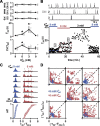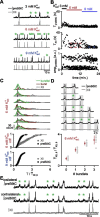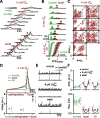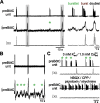Distinct inspiratory rhythm and pattern generating mechanisms in the preBötzinger complex
- PMID: 23719793
- PMCID: PMC3737080
- DOI: 10.1523/JNEUROSCI.4143-12.2013
Distinct inspiratory rhythm and pattern generating mechanisms in the preBötzinger complex
Abstract
In the mammalian respiratory central pattern generator, the preBötzinger complex (preBötC) produces rhythmic bursts that drive inspiratory motor output. Cellular mechanisms initiated by each burst are hypothesized to be necessary to determine the timing of the subsequent burst, playing a critical role in rhythmogenesis. To explore mechanisms relating inspiratory burst generation to rhythmogenesis, we compared preBötC and hypoglossal (XII) nerve motor activity in medullary slices from neonatal mice in conditions where periods between successive inspiratory XII bursts were highly variable and distributed multimodally. This pattern resulted from rhythmic preBötC neural population activity that consisted of bursts, concurrent with XII bursts, intermingled with significantly smaller "burstlets". Burstlets occurred at regular intervals during significantly longer XII interburst intervals, at times when a XII burst was expected. When a preBötC burst occurred, its high amplitude inspiratory component (I-burst) was preceded by a preinspiratory component that closely resembled the rising phase of burstlets. Cadmium (8 μM) eliminated preBötC and XII bursts, but rhythmic preBötC burstlets persisted. Burstlets and preinspiratory activity were observed in ~90% of preBötC neurons that were active during I-bursts. When preBötC excitability was raised significantly, burstlets could leak through to motor output in medullary slices and in vivo in adult anesthetized rats. Thus, rhythmic bursting, a fundamental mode of nervous system activity and an essential element of breathing, can be deconstructed into a rhythmogenic process producing low amplitude burstlets and preinspiratory activity that determine timing, and a pattern-generating process producing suprathreshold I-bursts essential for motor output.
Figures







Similar articles
-
Evaluating the Burstlet Theory of Inspiratory Rhythm and Pattern Generation.eNeuro. 2020 Jan 15;7(1):ENEURO.0314-19.2019. doi: 10.1523/ENEURO.0314-19.2019. Print 2020 Jan/Feb. eNeuro. 2020. PMID: 31888961 Free PMC article.
-
Cholinergic neurotransmission in the preBötzinger Complex modulates excitability of inspiratory neurons and regulates respiratory rhythm.Neuroscience. 2005;130(4):1069-81. doi: 10.1016/j.neuroscience.2004.10.028. Neuroscience. 2005. PMID: 15653001 Free PMC article.
-
Emergent Elements of Inspiratory Rhythmogenesis: Network Synchronization and Synchrony Propagation.Neuron. 2020 May 6;106(3):482-497.e4. doi: 10.1016/j.neuron.2020.02.005. Epub 2020 Mar 3. Neuron. 2020. PMID: 32130872 Free PMC article.
-
Respiratory Rhythm Generation: The Whole Is Greater Than the Sum of the Parts.Adv Exp Med Biol. 2017;1015:147-161. doi: 10.1007/978-3-319-62817-2_9. Adv Exp Med Biol. 2017. PMID: 29080026 Review.
-
Breathing Rhythm and Pattern and Their Influence on Emotion.Annu Rev Neurosci. 2022 Jul 8;45:223-247. doi: 10.1146/annurev-neuro-090121-014424. Epub 2022 Mar 8. Annu Rev Neurosci. 2022. PMID: 35259917 Free PMC article. Review.
Cited by
-
Inspiratory rhythm generation is stabilized by Ih.J Neurophysiol. 2022 Jul 1;128(1):181-196. doi: 10.1152/jn.00150.2022. Epub 2022 Jun 8. J Neurophysiol. 2022. PMID: 35675444 Free PMC article.
-
Assessing inspiratory drive and effort in critically ill patients at the bedside.Crit Care. 2025 Jul 31;29(1):339. doi: 10.1186/s13054-025-05526-0. Crit Care. 2025. PMID: 40745324 Free PMC article. Review.
-
Ion channels in respiratory rhythm generation and sensorimotor integration.Neuron. 2025 Jul 21:S0896-6273(25)00469-6. doi: 10.1016/j.neuron.2025.06.011. Online ahead of print. Neuron. 2025. PMID: 40752487 Review.
-
Interactions between respiratory oscillators in adult rats.Elife. 2016 Jun 14;5:e14203. doi: 10.7554/eLife.14203. Elife. 2016. PMID: 27300271 Free PMC article.
-
Cell Type-Dependent Activation Sequence During Rhythmic Bursting in the PreBötzinger Complex in Respiratory Rhythmic Slices From Mice.Front Physiol. 2018 Sep 3;9:1219. doi: 10.3389/fphys.2018.01219. eCollection 2018. Front Physiol. 2018. PMID: 30233397 Free PMC article.
References
-
- Butera RJ, Jr, Rinzel J, Smith JC. Models of respiratory rhythm generation in the pre-Bötzinger complex: I. Bursting pacemaker neurons. J Neurophysiol. 1999a;82:382–397. - PubMed
-
- Butera RJ, Jr, Rinzel J, Smith JC. Models of respiratory rhythm generation in the pre-Bötzinger complex: II. Populations of coupled pacemaker neurons. J Neurophysiol. 1999b;82:398–415. - PubMed
-
- Del Negro CA, Johnson SM, Butera RJ, Smith JC. Models of respiratory rhythm generation in the pre-Bötzinger complex: III. Experimental tests of model predictions. J Neurophysiol. 2001;86:59–74. - PubMed
